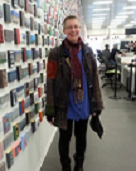I also feel everyone’s backs resting on the backs of chairs
and the sofa, relaxed, as Anne Simpson reads a passage about “sinking into
chairs.” The comfort I feel from everyone in the room, and from the room
itself, makes me realize how vital, healing, warm and welcome it is to be in
good company listening to someone read. Her reading is an extension of her
speech. She begins by talking to us and, seamlessly, her voice launches into
reading. Her voice, now with words and rhythms a bit more formalized, stems
from the same place, the same discerning mind. We listen in a living room that
doesn’t belong to anyone in particular anymore but where reading, writing and
contemplating belong to all who visit.
Suddenly I am reminded of being in a similar small circle
of legs, feet and chairs in a convent outside Montreal. After a concert we gave in their
chapel, Alex (my accompanist) and I are invited to sit with the nuns in a
circle while we talk about music, flowers and this and that. It is comforting
to be there, in the quiet and circular serenity of 14 rocking chairs.
Left to right: Janet Maybee, Suzie LeBlanc, Mary Ellen Sullivan, Sandra Barry, Anne Simpson, Jill MacLean, Harry Thurston, Linda Hargrave (photo taken by Paul Kellogg -- at the Elizabeth Bishop House, Great Village, N.S.
Today, I am aware of everyone’s toes pointing towards the
middle of the room, toward each other. It’s as though our feet are anxious to
converse as well. Why am I attracted to everyone’s feet, instead of to their
facial expressions? I’m finding our feet so expressive. They are not engaging
in fascinating and inspiring intellectual pursuits, but they are eager to meet
and commune, almost to touch. If the chairs came a little closer, our feet
would touch, and we might giggle and talk less. If we were children, how
quickly our feet would have touched, and after a laugh, moved on to another
game.
The reason for our gathering was to listen to Griffin Poetry
Prize winner (and winner of many other prizes) Anne Simpson, and it was a
treat. She chose wonderful excerpts from The
Maram Grass, a few poems from her collection Is, and an excerpt of her novel Falling,
which made me want to read the book instantly so I bought a copy.
How lucky we were to be in this intimate and informal
setting, able to ask questions about the writing process, or how it is to have
your work read out loud by someone else, or about the role of the weather, or
place, in a novel. Are these things peripheral, or essential to the unfolding
of the story? How can they help to connect us to the world we are creating? We
talked about connecting disparate things in poetry to create surprising and
compelling metaphors, and about how scientists also create by connecting
disparate things, and how these two worlds are more related than people
realize. I can’t remember everything that was said but it was a very rich
afternoon.
At the end of the day, we were treated to an unusual
spectacle when a pileated woodpecker began carving a large living space in the
dead tree in front of the veranda. He was very close to us and we watched him
work for a long time before he flew away, or took a break.
The creature in question (photo by Suzie LeBlanc)
Sandra Barry has been organizing these afternoons at the EB
House for years, inviting different artists to share their work. It was my
second time and I strongly recommend going. This is the type of unique event
that happens in a place like Nova
Scotia, organized by generous and devoted people like
Sandra. It is why I love living here and I wish I could attend more often. They
replace the family and community life so many of us have lost in our frenzied
pursuit of careers.
Checking things out (photo by Anne Simpson)












